From left to right: Lol Tolhurst (Keyboards) | Simon Gallup (Bass) | Robert Smith (Vocal and Guitar) | Porl Thompson (Guitar) | Boris Williams (Drums)
It all started in 1976 as '
Easy Cure', formed by Robert Smith (vocals, guitar) along with schoolmates Michael Dempsey (bass), Lol Tolhurst (drums) and local guitar hero Porl Thompson. They began writing and demoing their own songs almost immediately, playing throughout 1977 in Southern England to an ever growing army of fans.
Biography
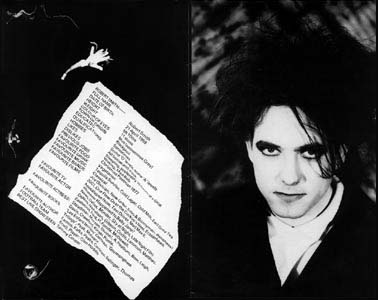 Robert Smith Robert Smith
Full name: Robert Smith
Date of birth: 21 April 1959
Height: 5ft 10ins
Weight: 11 stone
Color of eyes: blue (sometimes grey)
Town of origin: Blackpool
Educated: Sometimes
Qualifications: Some "O" levels, some "A" levels
Hobbies: All below and more
Likes: Sleeping, preferably 16 hours at a time
Dislikes: Waking, Mad Bob.
Previous jobs: Christmas postman 1977
Favorite food: Vegetarian
Favorite drink: Tequila Sunrise, cold lager, cold milk, earl grey tea
Favorite music: classical
Favorite bands: Joy Division, New Order, Echo & the Bunnymen, Banshees!
Favorite films: 2001, One Flew Over The Cuckoo's Nest, Eraserhead, Apocalypse Now, Taxi Driver, Mad Max II, Whatever Happened to Baby Jane?
Favorite TV: News, Dallas, Minder, Sky At Night, Late Night Film
Favorite actor: De Niro, Nicholson, Gibson, Curtis, Lemmon, Matthau
Favorite actress: Steadman, Monroe, Divine!, A. Hepburn, Bow, Leigh, Davis, Crawford, Kinski, Poole.
Favorite books: "Les Enfants Terribles" Cocteau, "Gormenghast Trilogy" Peak, Malagor
Favorite author: Camus, Kafka, Peake, Cocteau, Salinger, Thomas
Favorite team: Brazil, player: Glen Hoodle
Best Live Show seen: Tommy Cooper
| 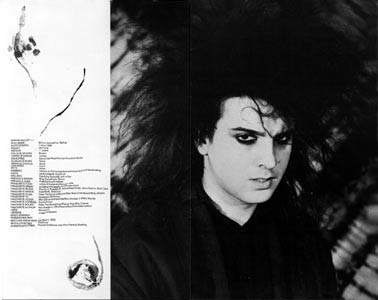
Simon Gallup
Full name: Simon Johnathon Gallup
Date of birth: 1 June 1960
Height: 5ft 11ins
Weight: 11 stone
Color of eyes: brown
Town of origin: Horley
Educated: Balcombe Road Comprehensive Horley
Qualifications: none
Marital status: none
Children: none
Pets: none
Hobbies: games on TV computers and buying groceries/drinking
Likes: ice & vodka & grapefruit
Dislikes: catching trains & lack of ice
Previous bands: Mag Spys/Fools Dance
Previous jobs: plastics mould dipper
Favorite food: Indian/cheese and tomato rools
Favorite drink: vodka and grapefruit with lots of ice
Favorite music: The Cure, Kate Bush, some New Order, John Martyn, Nick Cave
Favorite bands: Kate Bush, The Cure
Favorite films: Peter Pan/Irma la Douce/Star Wars/First Blood/Willy Wonka
Favorite tv: Catweazle/Bullseye
Favorite actor: Mel Gibson sometimes/Roy Kinnear in Willy Wonka
Favorite actress: Carrie Fisher
Favorite books: Peter Pan/Something Wicked This Way Comes
Favorite author: Ray Bradbury, Charlie and the Chocolate Factory
Hero: Wolverine
Heroine: Judge Anderson
Most admired person and why: -
Best Live Show seen: Genesis in 1973
Best experience: The Cure
Worst experience: planes/godstone fair/this plane is shaking |
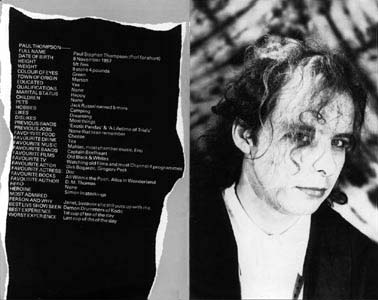
Paul Thompson
Full name: Paul Stephen Thompson (Porl for short)
Date of birth: 8 November 1957
Height: 5ft 7ins
Weight: 9 stone 4 pounds
Color of eyes: green
Town of origin: Merton
Educated: yes
Qualifications: none
Marital status: happy
Children: none
Pets: Jack Russel named 5 mins
Hobbies: camping
Likes: dreaming
Dislikes: most things
Previous bands: Exotic Pandas & A Lifetime of Trials
Previous jobs: none that I can remember
Favorite food: cheese
Favorite drink: tea
Favorite music: Mahler, most chamber music, Eno
Favorite bands: Captain Beefheart
Favorite films: old black & whites
Favorite tv: watching old films and most Channel 4 programmes
Favorite actor: Dirk Bogarde, Gregory Peck
Favorite actress: Doc
Favorite books: all Winnie the Pooh, Alice in Wonderland
Favorite author: D.M. Thomas
Hero: none
Heroine: Simon in stockings
Most admired person and why: Janet, because she still puts with me
Best Live Show seen: Demon drummers of Kodo
Best experience: 1st cup of tea of the day
Worst experience: last cup of tea of the day
| 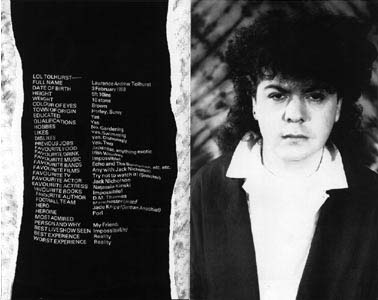 Lol Tolhurst Lol Tolhurst
Full name: Laurence Andrew Tolhurst
Date of birth: 3 February 1959
Height: 5ft 10ins
Weight: 10 stone
Color of eyes: brown
Town of origin: Horley, Surrey
Educated: yes
Qualifications: yes
Hobbies: no. gardening
Likes: yes, swimming
Dislikes: yes, dishonesty
Previous jobs: yes, two
Favorite food: Japanese, anything exotic
Favorite drink: Irish whiskey
Favorite music: impossible!
Favorite bands: Echo and the Bunnymen, etc. etc.
Favorite films: any with Jack Nicholson
Favorite TV: try not to watch it! (snooker)
Favorite actor: Jack Nicholson
Favorite actress: Natassia Kinski
Favorite books: impossible!
Favorite author: D.M. Thomas
Favorite team: Manchester United
Hero: Jade Knipe (German Anarchist)
Heroine: Porl
Most admired person and why: my friends
Best Live Show seen: impossible! (life)
Best experience: reality
Worst experience: reality |
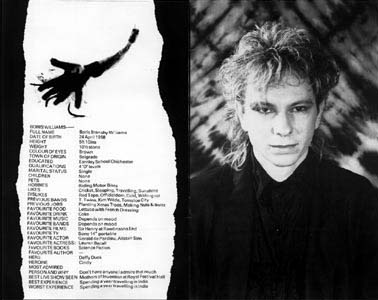
Boris Williams
Full name: Boris Bransby Williams
Date of birth: 24 April 1958
Height: 5ft 10ins
Weight: 10 1/2 stone
Color of eyes: brown
Town of origin: Belgrade
Educated: Earnley School Chichester
Qualifications: 4"O" levels
Marital status: single
Children: none
Pets: none
Hobbies: riding motor bikes
Likes: cricket, sleeping, traveling, sunshine
Dislikes: red tape, officialdom, cold, waking up
Previous bands: T.Twins, Kim Wilde, Tomatoe City
Previous jobs: planting Xmas trees, making nuts & bolts
Favorite food: lettuce with French dressing
Favorite drink: Coke
Favorite music: depends on mood
Favorite bands: depends on mood
Favorite films: Sir Henry at Rawlinsons End
Favorite TV: Sony 14" portable
Favorite actor: Gerald de Pardieu (sic), Alistair Sim
Favorite actress: Lauren Bacall
Favorite books: science fiction
Favorite author: -
Hero: Daffy Duck
Heroine: Cindy
Most admired person and why: don't have anyone I admire that much
Best Live Show seen: Mothers of Invention at Royal Festival Hall
Best experience: spending a year traveling in India
Worst experience: spending a year traveling in India
 Lol Tolhurst, Robert Smith & Michael Dempsey Lol Tolhurst, Robert Smith & Michael Dempsey |  Robert Smith, Michael Dempsey & Lol Tolhurst Robert Smith, Michael Dempsey & Lol Tolhurst

 Michael Dempsey, Robert Smith & Lol Tolhurst Michael Dempsey, Robert Smith & Lol Tolhurst  Lol Tolhurst & Robert Smith Lol Tolhurst & Robert Smith
|
History
In 1978 the 'Easy' was dropped, along with Porl, and an eager trio now known simply as The Cure were quickly signed to Chris Parry's new Fiction label.

In May 1979 their debut album Three Imaginary Boys was released to great acclaim, and as the band toured extensively around the UK, the singles “Boys Don't Cry” and “Jumping Someone Else's Train” were released. Michael left the band at the end of the year, and Simon Gallup (bass) and Matthieu Hartley (keyboards) joined. In early 1980 the 4-piece Cure embarked on an exploration of the darker side of Robert's songwriting, and emerged with the minimalist classic Seventeen Seconds, along with their first bona-fide 'hit single' “A Forest.”
After an intense world tour Matthieu left the group, and in early 1981 the trio recorded an album of mournful atmospheric soundscapes entitled Faith, which included another successful single in “Primary.” The band then set out on a second global trek, named “The Picture Tour,” during which they released the non-album single “Charlotte Sometimes.” In 1982 The Cure went back into the studio, and their increasingly ugly fascination with despair and decay culminated in the unrelenting sonic attack of Pornography. An intensely volatile tour ensued, and the single “The Hanging Garden” was released just as Simon left the band.

After pushing the limits of excess, Robert felt he had to change things, and did so by 'going pop' again. Rejuvenated, the now 2-piece Cure released their first real dance single, the cheesy “
Let's Go To Bed,” and during the making of the accompanying video forged a colorful and lasting relationship with direc

tor Tim Pope. The band continued into 1983 with the groovy electronic dance of “The Walk,” followed by the demented cartoon jazz of “
The Lovecats.” In 1984 The Top was released, a strange hallucinogenic mix, which contained the infectiously psychedelic single “The Caterpillar.” The world ‘Top Tour’ saw the band expand to a 5-piece, with the addition of Andy Anderson (drums) and Phil Thornalley (bass), and the return of Porl Thompson (guitar).
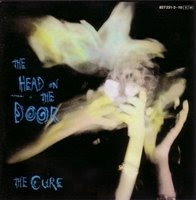
The new Cure sound was captured live for the album Concert. Andy and Phil left soon after the end of the tour, and were replaced by Boris Williams (drums) and further returnee Simon Gallup (bass). This new incarnation started work on 1985's
The Head On The Door with a very real sense of 'something happening'... The vibrant hit single “Inbetween Days” was followed up by “Close To Me,” and the ensuing world tour paved the way for the massive success of the singles collection Standing On A Beach in 1986. That summer saw the band headline the Glastonbury Festival for the first time, and a year of extensive gigs and festivals was crowned by Tim Pope's live concert film The Cure In Orange.

In 1987 The Cure brought out
Kiss Me Kiss Me Kiss Me, an immense double album of extreme and extraordinary stylistic range, and with the arrival of Roger O'Donnell on keyboards the 6-piece Cure traveled the world with the 'Kissing Tour', enjoying 4 more hit singles along the way. The wonderfully atmospheric Disintegration was demoed in 1988 and released in 1989, and despite being a work of powerful brooding grandeur, it too gave rise to 4 hit singles. The awesome 'Prayer Tour' that followed, with the band back down to a 5-piece following the departure of Lol Tolhurst, included some of The Cure's best performances to date, and was captured live for the album Entreat.
 |
| In early 1990 Roger O'Donnell left the group, and was replaced by long-time band friend Perry Bamonte, just in time for a series of headlining European festival shows that included the band's second Glastonbury headline slot. The album Mixed Up was released, supported by the re-mixed singles “Never Enough,” “Close To Me” and “A Forest,” and in 1991 The Cure at last won some long overdue “home” recognition with a Brit Award for “Best British Group.” |
The Cure Gets Inducted Into The Rock Walk in Hollywood
Members of the English rock band The Cure (from left): Jason Cooper, Simon Gallup, Robert Smith, Roger O'Donnell and Perry Bamonte place their hands in cement during their induction into the Rock Walk at the Guitar Center on April 30, 2004 in Hollywood, California.

In 1992 they produced
Wish, a richly diverse multi-faceted guitar driven album hailed by some as their best work to date. It spawned 3 fabulous hit singles, and the glorious ‘Wish Tour' that followed was a worldwide sell-out. The sheer power of the shows inspired the release of two live works in 1993, Paris and Show. Immediately after the tour ended, guitarist Porl Thompson left the band again (this time with a smile!), and The Cure headlined the XFM 'Great Xpectations Show' in London's Finsbury Park as a 4-piece. The band also contributed '”Burn” to the film ‘The Crow’ and covered “Purple Haze” for the Hendrix tribute album 'Stone Free'.
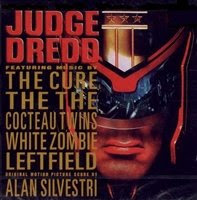
In 1994 Boris Williams decided to move on, and in early 1995 Jason Cooper took up residency behind the drum kit, with Roger O'Donnell rejoining once more on keyboards. Work on the next album was interspersed with recording “Dredd Song” for the film ‘
Judge Dredd’, a cover of Bowie's “Young Americans” for an XFM album, and headlining several major European festivals, including the 25th Glastonbury. Wild Mood Swings was released in 1996, and went straight into almost every top ten around the world. The Cure hit the road once more with 'The Swing Tour', their longest to date, and released 4 more singles.

Galore, the follow up singles and video compilation to
Standing On A Beach, was released in 1997, after which work took place in 1998 on a variety of projects, including “More than This” for the ‘X Files’ album, and a memorable appearance by Robert in the TV cartoon show ‘South Park’! In 1999 the band completed the recording and mixing of what many regarded as their best studio album so far, the Grammy Nominated Bloodflowers. With it's release in 2000 the band set off on the massive world-wide ‘Dreamtour' - playing to more than a million people in 9 months.

2001 saw the long awaited release of the Cure's
Greatest Hits album, which featured all the band's biggest selling singles along with 2 new songs, the elegiac “Cut Here” and the ebullient “Just Say Yes,” a duet with Saffron. This year also saw the end of the group's relationship with Fiction Records, the label they had been instrumental in starting 23 years before.
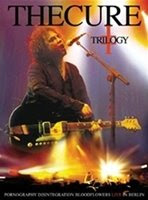
In 2002 the band spent the summer headlining a number of European Festivals before going into rehearsals for two very special nights in November at the Tempodrom Berlin, where they performed all the tracks from Pornography, Disintegration and Bloodflowers plus encores! Both performances were shot in Hi-Def video on 12 cameras, and Trilogy DVD was released.

In 2003 as another chapter of The Cure story opened, the band signing a 3 album global deal with the Geffen label. 2004 saw the release of
Join the Dots, a 4cd Box set compiled by Robert of all the B-sides and Rarities, followed by the widely acclaimed new album The Cure, co-produced with the renowned Ross Robinson. 3 singles, “The End Of The World”, “alt.end” and “Taking Off” all hit big, and another hugely successful world tour ensued, with the 23 date North American Curiosa Festival leg especially notable for seeing the band supported by a number of hand picked younger bands including Interpol, Mogwai, The Rapture and Muse. The year ended with an MTV Icon Award presented at a special televised London show.
In 2005 Perry Bamonte and Roger O’Donnell left the band and Porl Thompson joined for a third time. The quartet’s debut show was headlining Live 8 Paris, followed by a number of other summer European Festivals. The first four Cure albums (Three Imaginary Boys, Seventeen Seconds, Faith and Pornography) were re-released, with Robert providing 'rarities' for Deluxe Edition extras CD's, as part of an ongoing campaign to re-master and re-issue all the Cure albums. Immediately after closing a week of Teenage Cancer Trust Shows at the Royal Albert Hall in April 2006, the band started recording their 13th studio album, breaking off in June to allow Robert to work on a live DVD. In August the second set of re-releases (The Top, The Head On The Door, Kiss Me Kiss Me Kiss Me) was released, each album as a 2CD Deluxe Edition, along with 1983’s Glove album Blue Sunshine. In November Festival 2005, a 155 minute 5.1 DVD comprising a 30 song selection of live performances captured the previous summer by a mix of fans, crew and ‘on-the-night-big-screen cameras’, was put out.
Spring 2007 saw The Cure headline the Miami Ultra Music Festival before heading back into the studio to continue work on new songs. The 11 show Australasian leg of ‘The Cure 4Tour 2007-2008’ kicked off in July with a headline slot at the Fuji Rock Festival, the band’s first performance in Japan since 1984, before moving on through Hong Kong, Singapore, Australia and New Zealand. In October the band headlined the San Francisco Download Festival, before playing 3 wild nights in Mexico City at the Palacio de los Deportes, followed by an outstanding performance at the MTV Latin America Awards.
In February 2008 The Cure kicked off the 23 date European leg of ‘The 4Tour’, and in May released “The Only One”, the first of 4 singles to be released every 13th of the month for 4 months. “Freakshow”, “Sleep When I’m Dead” and “The Perfect Boy” followed, and as the band continued ‘The 4Tour’ with a sell-out 27 date North American leg, all 4 singles reached #1 on the Billboard chart. Indeed, for one remarkable week in August, 4 Cure singles were in the USA Top 20 at the same time! In September the “
Hypnagogic States” EP was released, featuring remixes of the first 4 singles by acclaimed younger artists Gerard Way (My Chemical Romance), Pete Wentz & Patrick Stump (Fall Out Boy), Jade Puget (AFI) and 30 Seconds To Mars. 4Tour support band 65 Days Of Static joined in the fun, remixing all four singles as one track. All artist royalties from this EP were donated to the International Red Cross.

In a radical move the new album
4:13 Dream was performed in its 13 song entirety by The Cure 2 weeks prior to release at a live broadcast MTV event in the Piazza San Giovanni in Rome before an estimated crowd of 75,000 and a potential TV audience of 200 million. The reaction to the event has been awesome, with many fans already acclaiming this new Cure album as a bona fide classic…
In late October
4:13 Dream, The Cure’s 13th studio album - recorded, engineered, produced and mixed at Parkgate Studios UK by Robert Smith and Keith Uddin - is released worldwide…
 The Church is an Australian rock band formed in Canberra in 1980. Initially associated with New Wave and the neo-psychedelic sound of the mid 1980s, their music later became more reminiscent of "progressive rock," featuring long instrumental jams and complex guitar interplay.
The Church is an Australian rock band formed in Canberra in 1980. Initially associated with New Wave and the neo-psychedelic sound of the mid 1980s, their music later became more reminiscent of "progressive rock," featuring long instrumental jams and complex guitar interplay. 


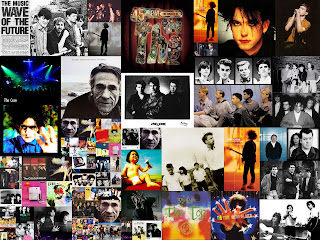
 New Wave is a rock genre that originated in the late 1970s and continued in the 1980s. It emerged from punk rock as a reaction against the popular music of the 1970s. New Wave was basically the reinvention of rock 'n' roll of the 1960s but it also incorporated various influences as well as aspects of mod subculture, electronic music, disco, and funk.
New Wave is a rock genre that originated in the late 1970s and continued in the 1980s. It emerged from punk rock as a reaction against the popular music of the 1970s. New Wave was basically the reinvention of rock 'n' roll of the 1960s but it also incorporated various influences as well as aspects of mod subculture, electronic music, disco, and funk. 

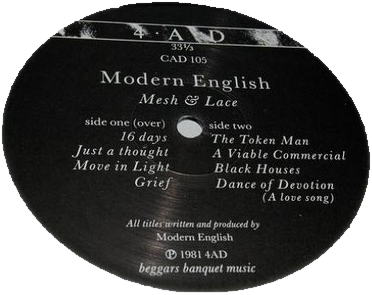


![I Melt with You [Cassette Single]](http://d.yimg.com/ec/noPicture80.jpg)







![After the Snow [Bonus Tracks]](http://d.yimg.com/ec/image/v1/release/31404;size=78x78;fallback=defaultImage)


 Originally known as
Originally known as 





















 Robert Smith
Robert Smith

 Lol Tolhurst
Lol Tolhurst






 After pushing the limits of excess, Robert felt he had to change things, and did so by 'going pop' again. Rejuvenated, the now 2-piece Cure released their first real dance single, the cheesy “
After pushing the limits of excess, Robert felt he had to change things, and did so by 'going pop' again. Rejuvenated, the now 2-piece Cure released their first real dance single, the cheesy “ tor Tim Pope. The band continued into 1983 with the groovy electronic dance of “The Walk,” followed by the demented cartoon jazz of “
tor Tim Pope. The band continued into 1983 with the groovy electronic dance of “The Walk,” followed by the demented cartoon jazz of “ The new Cure sound was captured live for the album Concert. Andy and Phil left soon after the end of the tour, and were replaced by Boris Williams (drums) and further returnee Simon Gallup (bass). This new incarnation started work on 1985's
The new Cure sound was captured live for the album Concert. Andy and Phil left soon after the end of the tour, and were replaced by Boris Williams (drums) and further returnee Simon Gallup (bass). This new incarnation started work on 1985's  In 1987 The Cure brought out
In 1987 The Cure brought out 
 In 1992 they produced
In 1992 they produced  In 1994 Boris Williams decided to move on, and in early 1995 Jason Cooper took up residency behind the drum kit, with Roger O'Donnell rejoining once more on keyboards. Work on the next album was interspersed with recording “Dredd Song” for the film ‘
In 1994 Boris Williams decided to move on, and in early 1995 Jason Cooper took up residency behind the drum kit, with Roger O'Donnell rejoining once more on keyboards. Work on the next album was interspersed with recording “Dredd Song” for the film ‘ Galore, the follow up singles and video compilation to
Galore, the follow up singles and video compilation to 


 In a radical move the new album
In a radical move the new album